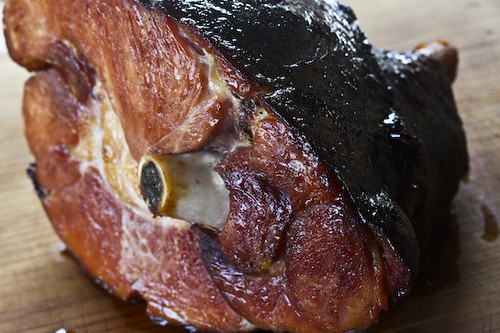The Only Easter Ham You'll Ever Need
I don't think it's a huge secret that I'm not a big meat eater. It's not that I don't eat meat, it's just that I prefer it as an accompaniment to something green rather than the main attraction. But for Easter, nothing quite beats a roasted fresh ham for a number of reasons: 1) it's impressive. If you're going to feast, you must have a centerpiece, and a fresh ham can't be topped. 2) It's easy. If you consider throwing a huge hunk of meat in the oven and setting the timer to be easy. This particular recipe only requires basting for the last 1:15. 3) Leftovers. This being perhaps the best reason to roast your ham. You get the coveted ham bone, which is one of the most prized additions to spring soups like split pea, not to mention all the leftover meat itself.
Before this weekend, however, I was a fresh-ham-roasting-virgin. So when I was contacted to review Bruce Weinstein and Mark Scarbrough's new book Ham: An Obsession with the Hindquarter, well, I guess you can tell what my answer was. You might recognize the authors from their prolific collaborate efforts at mono-thematic books: books dedicated to pizza, to frozen desserts, to potatoes, to chocolate, to peanut butter (!) and now to ham. Their writing style is extremely engaging, each chapter introduction reads like a vignette from a novel. And in the present recipe, when they suggested you dab on the maple syrup with a mind to Impressionism, not Abstract Expressionism? Well, the art historian in me did a little happy dance (not to mention that it was damn good advice).
I have a few more things on deck from the book to help use up some of our very coveted leftovers. But I have to tell you, this recipe, this maple-spice glazed ham alone makes the book worth its keep. It's stellar, you guys. Seriously. Not to mention that after an evening reading Ham like a novel, you'll find yourself with all sorts of new knowledge, not just about the fresh ham, but about European dry-cured hams (things like the Italian culatello, the Bulgarian elenski but, the French jambon de bayonne and the Spanish jamón ibérico), American country hams, and wet-cured hams which make up the majority of cured hams in the US. And it's full of traditional and not-so-traditional ways to use them all (like the Moroccan-style Roasted Ham which even the authors admit to be a cultural oxymoron). So we'll start with this, the Roasted Fresh Ham with a Maple-Spice Glaze because I'm sure it's the only fresh ham recipe you'll ever need. For one thing, I was only able to snap basically that one picture above before everyone descended on the thing. The measure of a great ham.
Roasted Fresh Ham with a Maple-Spice Glaze
Reprinted with permission from Bruce Weinstein and Mark Scarbrough's Ham: An Obsession with the Hindquarter with my parenthetical notes
One 8-10 pound bone-in fresh ham, preferably from the shank end, any rind removed (my ham was 8.5 pounds and it fed 11 adults with leftovers)
1 teaspoon sugar
1 teaspoon ground cinnamon
1/2 teaspoon ground allspice
1/2 teaspoon ground cloves
1/2 teaspoon grated nutmeg
1/2 teaspoon salt
1/2 cup real maple syrup (please use the real stuff! After all of this effort, you deserve it)
Put the Dickensian joint in a large roasting pan, preferably one that's shiny enough to reflect lots of ambient heat and not so flimsy that it tips willy-nilly when you pick it up. Set the oven rack as high as it can go and still afford the ham at least 2 inches of head space. Leave the roast in its pan out on the counter and fire the oven up toe 325F.
Mix the sugar, cinnamon, allspice, cloves, nutmeg, and salt in a small bowl. Wash and dry your hands, then smooth the spice mixture all over the ham's external surface. Work it down into some the crevices, but be careful to avoid any deep-tissue massage. A ham is a complex structure of muscle groups - too much massage and they can come apart like Goldie Hawn in Death Becomes Her.
Cover the whole kit and caboodle with aluminum foil, shove it in the oven, and leave it alone for 3 1/2 hours, while you go do whatever it is you do when a big, sweating hunk of meat is roasting in your oven.
Peel off the aluminum foil. Baste the ham with about half the maple syrup, preferably using a basting brush. Take it easy so you don't knock off the spice coating. Use small strokes - think Impressionism, not Abstract Expressionism. Or just dribble the syrup off a spoon.
Continue roasting the ham, uncovered this time, basting every 15 minutes or so with more maple syrup as well as any pan drippings, until an instant-read thermometer inserted into the thickets part of the meat without touching bone registers 170F, about 1 1/4 hours. If it starts to singe or turn too dark, tent it loosely with foil, uncovering it just at the last to get it back to crunchy-crisp.
Transfer the ham to a cutting or carving board and let it rest at room temperature for 15 minutes before carving into slices.
Subscribe to:
Post Comments (Atom)

No comments:
Post a Comment